Experimental Investigation on the Low-Velocity Impact Response of Tandem Nomex Honeycomb Sandwich Panels
Abstract
1. Introduction
2. Material and Specimen
2.1. Materials
2.2. Specimens
3. Experimental Methods
4. Experimental Results and Discussion
4.1. Impact Response with Hemispherical Impactor
4.1.1. Failure Modes
4.1.2. Contact Force and Energy-Absorption History
4.2. Impact Response with Flat Impactor
4.2.1. Failure Modes
4.2.2. Contact Force and Energy-Absorption History
4.3. Effects of Impactor Shape on Failure Modes
4.4. Comparison the Impact Resistance of Sandwich Panels
4.4.1. First Peak Force
4.4.2. Impact Displacement
4.4.3. Factors of Impact Resistance
5. Conclusions
- For foam-unfilled sandwich panels, the impact resistance of multi-layer honeycomb sandwich panels was better than that of single-layer honeycomb sandwich panels. The three-layer gradient-tandem honeycomb sandwich panel exhibited the best impact resistance. Compared to the single-layer sandwich panel, the first peak force increased by 18.58% and the maximum impact displacement decreased by 23%.
- Foam-filled structures significantly improved the impact resistance of tandem honeycomb sandwich panels. When the impactor shape was hemispherical, the first peak force of a gradient-filled tandem honeycomb sandwich panel improved by 34.84%, and the impact displacement was reduced by 50.98% (compared with a single-layer honeycomb sandwich panel). However, it is sensitive to the impact shape. The change values of the first peak force were 21.97% and 21.22% under a flat impactor with 50 and 100 J of impact energy, respectively.
- The shape of the impactor significantly affected the failure modes of the sandwich panels. The hemispherical impactor produced perforations in the shape of concave circles, forming petal-like cracking. The flat impactor caused perforation with a convex and circular hole. Furthermore, the flat impactor caused more severe damage to the sandwich panels than the hemispherical impactor with the same impact energy.
- The foam-filled structure affects the characteristics of the impact response of the tandem honeycomb structure. Gradient-tandem honeycomb sandwich panels exhibited better impact resistance than uniform-tandem honeycomb sandwich panels. In the foam-filled structure, the two tandem structures exhibited an approximate impact resistance. However, the gradient-tandem structure was still better than the uniform-tandem structure in terms of impact displacement.
- The low-velocity-impact response of tandem sandwich panels with different core types was investigated in this study with hemispherical and flat impactors. However, the effects caused by other shapes of impactors should have been considered. Furthermore, the effect of horizontal misalignment of the core layer of the multi-layer sandwich panel is also not considered due to the limitation of the manufacturing process.
- When the structural parameters of gradient-tandem honeycomb sandwich panels are changed, their impact resistance also changes. In addition, the impact angle is also an influencing factor for impact damage and deserves further research. Further works are supposed to focus on developing numerical models for gradient-tandem honeycomb sandwich panels to analyze the effect of these parameters on the failure processes.
Author Contributions
Funding
Institutional Review Board Statement
Data Availability Statement
Conflicts of Interest
References
- Ivañez, I.; Santiuste, C.; Barbero, E.; Sanchez-Saez, S. Numerical modelling of foam-cored sandwich plates under high-velocity impact. Compos. Struct. 2011, 93, 2392–2399. [Google Scholar] [CrossRef]
- Zhou, J.; Hassan, M.Z.; Guan, Z.; Cantwell, W.J. The low velocity impact response of foam-based sandwich panels. Compos. Sci. Technol. 2012, 72, 1781–1790. [Google Scholar] [CrossRef]
- Kurşun, A.; Şenel, M.; Enginsoy, H.M.; Bayraktar, E. Effect of impactor shapes on the low velocity impact damage of sandwich composite plate: Experimental study and modelling. Compos. Part B 2016, 86, 143–151. [Google Scholar] [CrossRef]
- Demircioğlu, T.; Balıkoğlu, F.; İnal, O.; Arslan, N.; Ay, İ.; Ataş, A. Experimental investigation on low-velocity impact response of wood skinned sandwich composites with different core configurations. Mater. Today Comm. 2018, 17, 31–39. [Google Scholar] [CrossRef]
- Yang, X.; Ma, J.; Shi, Y.; Sun, Y.; Yang, J. Crashworthiness investigation of the bio-inspired bi-directionally corrugated core sandwich panel under quasi-static crushing load. Mater. Des. 2017, 135, 275–290. [Google Scholar] [CrossRef]
- Rong, Y.; Liu, J.; Luo, W.; He, W. Effects of geometric configurations of corrugated cores on the local impact and planar compression of sandwich panels. Compos. Part B 2018, 152, 324–335. [Google Scholar] [CrossRef]
- Wu, X.; Yu, H.; Guo, L.; Zhang, L.; Sun, X.; Chai, Z. Experimental and numerical investigation of static and fatigue behaviors of composites honeycomb sandwich structure. Compos. Struct. 2019, 213, 165–172. [Google Scholar] [CrossRef]
- Deng, J.; Gong, X.; Xue, P.; Yin, Q.; Wang, X. A comprehensive analysis of damage behaviors of composite sandwich structures under localized impact. Mech. Adv. Mater. Struct. 2022, 1–14. [Google Scholar] [CrossRef]
- Xie, S.; Jing, K.; Zhou, H.; Liu, X. Mechanical properties of Nomex honeycomb sandwich panels under dynamic impact. Compos. Struct. 2020, 235, 111814. [Google Scholar] [CrossRef]
- Wu, J.; Zhou, J.; Kong, X.; Xu, Y.; Chen, Y.; Zhu, J.; Jin, F.; Wang, P. An Innovative Auxetic Honeycomb Sandwich Tube Fabrication and Mechanical Properties. Polymers 2022, 14, 4369. [Google Scholar] [CrossRef]
- Zhang, D.; Fei, Q.; Zhang, P. Drop-weight impact behavior of honeycomb sandwich panels under a spherical impactor. Compos. Struct. 2017, 168, 633–645. [Google Scholar] [CrossRef]
- Uğur, L.; Duzcukoglu, H.; Sahin, O.S.; Akkuş, H. Investigation of impact force on aluminium honeycomb structures by finite element analysis. J. Sandw. Struct. Mater. 2017, 22, 87–103. [Google Scholar] [CrossRef]
- Wang, Z.; Wang, X.; Liu, K.; Zhang, J.; Lu, Z. Crashworthiness index of honeycomb sandwich structures under low-speed oblique impact. Int J. Mech. Sci. 2021, 208, 106683. [Google Scholar] [CrossRef]
- Werner, G.; Sackman, J.L. An experimental study of energy absorption in impact of sandwich plates. Int. J. Impact. Eng. 1992, 12, 241–262. [Google Scholar] [CrossRef]
- Deng, Y.; Zhou, N.; Jia, H.; Wu, H. Experimental Study on the Ballistic Resistance of S-shaped CFRP Foldcore Sandwich Structure against Flat-Nosed Projectile Impacts. Appl. Compos. Mater. 2022, 29, 1275–1291. [Google Scholar] [CrossRef]
- Wang, H.; Wang, W.; Wang, B.; Fan, H. Foam-filling technique to improve low-velocity impact behaviors of woven lattice truss sandwich panels. Polym. Test. 2022, 114, 107714. [Google Scholar] [CrossRef]
- Velmurugan, R.; Babu, M.G.; Gupta, N.K. Projectile impact on sandwich panels. Int. J. Crashworthiness 2006, 11, 153–164. [Google Scholar] [CrossRef]
- Roy, R.; Park, S.; Kweon, J.; Choi, J. Characterization of Nomex honeycomb core constituent material mechanical properties. Compos. Struct. 2014, 117, 255–266. [Google Scholar] [CrossRef]
- Liu, L.; Wang, H.; Guan, Z. Experimental and numerical study on the mechanical response of Nomex honeycomb core under transverse loading. Compos. Struct. 2015, 121, 304–314. [Google Scholar] [CrossRef]
- Zhao, W.; Jia, R.; Li, X.; Zhao, J.; Xie, A.Z. Flatwise compression behavior of composite Nomex (R) honeycomb sandwich structure. J. Sandw. Struct. Mater. 2021, 24, 1169–1188. [Google Scholar] [CrossRef]
- Hong, S.; Pan, J.; Tyan, T.; Prasad, P. Dynamic crush behaviors of aluminum honeycomb specimens under compression dominant inclined loads. Int J. Plast. 2008, 24, 89–117. [Google Scholar] [CrossRef]
- Akatay, A.; Bora, M.Ö.; Çoban, O.; Fidan, S.; Tuna, V. The influence of low velocity repeated impacts on residual compressive properties of honeycomb sandwich structures. Compos. Struct. 2015, 125, 425–433. [Google Scholar] [CrossRef]
- Sahu, S.K.; Sreekanth, P.S.R.; Reddy, S.V.K. A Brief Review on Advanced Sandwich Structures with Customized Design Core and Composite Face Sheet. Polymers 2022, 14, 4267. [Google Scholar] [CrossRef] [PubMed]
- Saseendran, V.; Berggreen, C. Mixed-mode fracture evaluation of aerospace grade honeycomb core sandwich specimens using the Double Cantilever Beam–Uneven Bending Moment test method. J. Sandw. Struct. Mater. 2018, 22, 991–1018. [Google Scholar] [CrossRef]
- Chen, Y.; Hou, S.; Fu, K.; Han, X.; Ye, L. Low-velocity impact response of composite sandwich structures: Modelling and experiment. Compos. Struct. 2017, 168, 322–334. [Google Scholar] [CrossRef]
- Dai, X.; Yuan, T.; Zu, Z.; Ye, H.; Cheng, X.; Yang, F. Experimental investigation on the response and residual compressive property of honeycomb sandwich structures under single and repeated low velocity impacts. Mater. Today Comm. 2020, 25, 101309. [Google Scholar] [CrossRef]
- Xie, S.; Feng, Z.; Zhou, H.; Wang, D. Three-point bending behavior of Nomex honeycomb sandwich panels: Experiment and simulation. Mech. Adv. Mater. Struct. 2020, 28, 1917–1931. [Google Scholar] [CrossRef]
- Zhu, Y.; Sun, Y. Low-velocity impact response of multilayer foam core sandwich panels with composite face sheets. Int. J. Mech. Sci. 2021, 209, 106704. [Google Scholar] [CrossRef]
- Wang, E.; Li, Q.; Sun, G. Computational analysis and optimization of sandwich panels with homogeneous and graded foam cores for blast resistance. Thin-Walled Struct. 2020, 147, 106494. [Google Scholar] [CrossRef]
- Zhang, J.; Yuan, H.; Li, J.; Meng, J.; Huang, W. Dynamic response of multilayer curved aluminum honeycomb sandwich beams under low-velocity impact. Thin-Walled Struct. 2022, 177, 109446. [Google Scholar] [CrossRef]
- Pang, Y.; Yan, X.; Qu, J.; Wu, L. Dynamic response of polyurethane foam and fiber orthogonal corrugated sandwich structure subjected to low-velocity impact. Compos. Struct. 2022, 282, 114994. [Google Scholar] [CrossRef]
- Zou, T.; Tie, Y.; Duan, Y.; Cui, Z.; Zhan, Z. Low-Velocity Impact Resistance of Double-Layer Folded Sandwich Structure. Machines 2022, 10, 665. [Google Scholar] [CrossRef]
- Sun, Z.; Shi, S.; Guo, X.; Hu, X.; Chen, H. On compressive properties of composite sandwich structures with grid reinforced honeycomb core. Compos. Part B 2016, 94, 245–252. [Google Scholar] [CrossRef]
- Palomba, G.; Epasto, G.; Crupi, V.; Guglielmino, E. Single and double-layer honeycomb sandwich panels under impact loading. Int. J. Impact. Eng. 2018, 121, 77–90. [Google Scholar] [CrossRef]
- Sun, G.; Wang, E.; Wang, H.; Xiao, Z.; Li, Q. Low-velocity impact behaviour of sandwich panels with homogeneous and stepwise graded foam cores. Mater. Des. 2018, 160, 1117–1136. [Google Scholar] [CrossRef]
- Zhang, W.; Qin, Q.; Li, K.; Li, J.; Wang, Q. Effect of stepwise gradient on dynamic failure of composite sandwich beams with metal foam core subject to low-velocity impact. Int. J. Solids Struct. 2021, 228, 111125. [Google Scholar] [CrossRef]
- Fang, B.; Huang, W.; Xu, H.; Jiang, C.; Liu, J. High-velocity impact resistance of stepwise gradient sandwich beams with metal foam cores. Thin-Walled Struct. 2022, 181, 110054. [Google Scholar] [CrossRef]
- Jayaram, R.S.; Nagarajan, V.A.; Kumar, K.P.V. Mechanical performance of polyester pin-reinforced foam filled honeycomb sandwich panels. Sci. Eng. Compos. Mater. 2017, 25, 797–805. [Google Scholar] [CrossRef]
- Yang, J.; Ma, L.; Schröder, K.; Chen, Y.; Li, S.; Wu, L.; Schmidt, R. Experimental and numerical study on the modal characteristics of hybrid carbon fiber composite foam filled corrugated sandwich cylindrical panels. Polym. Test. 2018, 68, 8–18. [Google Scholar] [CrossRef]
- Taghizadeh, S.; Farrokhabadi, A.; Liaghat, G.; Pedram, E.; Malekinejad, H.; Mohammadi, S.F.; Ahmadi, H. Characterization of compressive behavior of PVC foam infilled composite sandwich panels with different corrugated core shapes. Thin-Walled Struct. 2019, 135, 160–172. [Google Scholar] [CrossRef]
- Burlayenko, V.N.; Sadowski, T. Analysis of structural performance of sandwich plates with foam-filled aluminum hexagonal honeycomb core. Comp. Mater. Sci. 2009, 45, 658–662. [Google Scholar] [CrossRef]
- Mozafari, H.; Khatami, S.; Molatefi, H.; Crupi, V.; Epasto, G.; Guglielmino, E. Finite element analysis of foam-filled honeycomb structures under impact loading and crashworthiness design. Int. J. Crashworthiness 2016, 21, 148–160. [Google Scholar] [CrossRef]
- Han, B.; Qin, K.; Zhang, Q.; Zhang, Q.; Lu, T.J.; Lu, B. Free vibration and buckling of foam-filled composite corrugated sandwich plates under thermal loading. Compos. Struct. 2017, 172, 173–189. [Google Scholar] [CrossRef]
- Corigliano, A.; Rizzi, E.; Papa, E. Experimental characterization and numerical simulations of a syntactic-foam glass-fibre composite sandwich. Compos. Sci. Technol. 2000, 60, 2169–2180. [Google Scholar] [CrossRef]
- Mahmoudabadi, M.Z.; Sadighi, M. A study on the static and dynamic loading of the foam filled metal hexagonal honeycomb—Theoretical and experimental. Mater. Sci. Eng. A 2011, 530, 333–343. [Google Scholar] [CrossRef]
- Sadowski, T.; Bęc, J. Effective properties for sandwich plates with aluminium foil honeycomb core and polymer foam filling—Static and dynamic response. Comp. Mater. Sci. 2011, 50, 1269–1275. [Google Scholar] [CrossRef]
- Liu, Q.; Fu, J.; Wang, J.; Ma, J.; Chen, H.; Li, Q.; Hui, D. Axial and lateral crushing responses of aluminum honeycombs filled with EPP foam. Compos. Part B 2017, 130, 236–247. [Google Scholar] [CrossRef]
- Arunkumar, M.; Pitchaimani, J.; Gangadharan, K.; Leninbabu, M. Vibro-acoustic response and sound transmission loss characteristics of truss core sandwich panel filled with foam. Aerosp. Sci. Technol. 2018, 78, 1–11. [Google Scholar] [CrossRef]
- Nia, A.A.; Sadeghi, M. The effects of foam filling on compressive response of hexagonal cell aluminum honeycombs under axial loading-experimental study. Mater. Des. 2010, 31, 1216–1230. [Google Scholar] [CrossRef]
- Roudbeneh, F.H.; Liaghat, G.; Sabouri, H.; Hadavinia, H. Experimental investigation of quasistatic penetration tests on honeycomb sandwich panels filled with polymer foam. Mech. Adv. Mater. Struct. 2018, 27, 1803–1815. [Google Scholar] [CrossRef]
- Liu, J.; Chen, W.; Hao, H.; Wang, Z. Numerical study of low-speed impact response of sandwich panel with tube filled honeycomb core. Compos. Struct. 2019, 220, 736–748. [Google Scholar] [CrossRef]
- Topkaya, T.; Solmaz, M.Y. Investigation of low velocity impact behaviors of honeycomb sandwich composites. J. Mech. Sci. Technol. 2018, 32, 3161–3167. [Google Scholar] [CrossRef]
- Manes, A.; Gilioli, A.; Sbarufatti, C.; Giglio, M. Experimental and numerical investigations of low velocity impact on sandwich panels. Compos. Struct. 2013, 99, 8–18. [Google Scholar] [CrossRef]
- Han, X.; Cai, H.; Sun, J.; Wei, Z.; Huang, Y.; Wang, A. Numerical Studies on Failure Mechanisms of All-Composite Sandwich Structure with Honeycomb Core under Compression and Impact Loading Conditions. Polymers 2022, 14, 4047. [Google Scholar] [CrossRef] [PubMed]
- Nia, A.A.; Sadeghi, M. An experimental investigation on the effect of strain rate on the behaviour of bare and foam-filled aluminium honeycombs. Mater. Des. 2013, 52, 748–756. [Google Scholar] [CrossRef]
- Mozafari, H.; Molatefi, H.; Crupi, V.; Epasto, G.; Guglielmino, E. In plane compressive response and crushing of foam filled aluminum honeycombs. J. Compos. Mater. 2014, 49, 3215–3228. [Google Scholar] [CrossRef]
- Hussein, R.D.; Ruan, D.; Lu, G.; Guillow, S.; Yoon, J.W. Crushing response of square aluminium tubes filled with polyurethane foam and aluminium honeycomb. Thin-Walled Struct. 2017, 110, 140–154. [Google Scholar] [CrossRef]

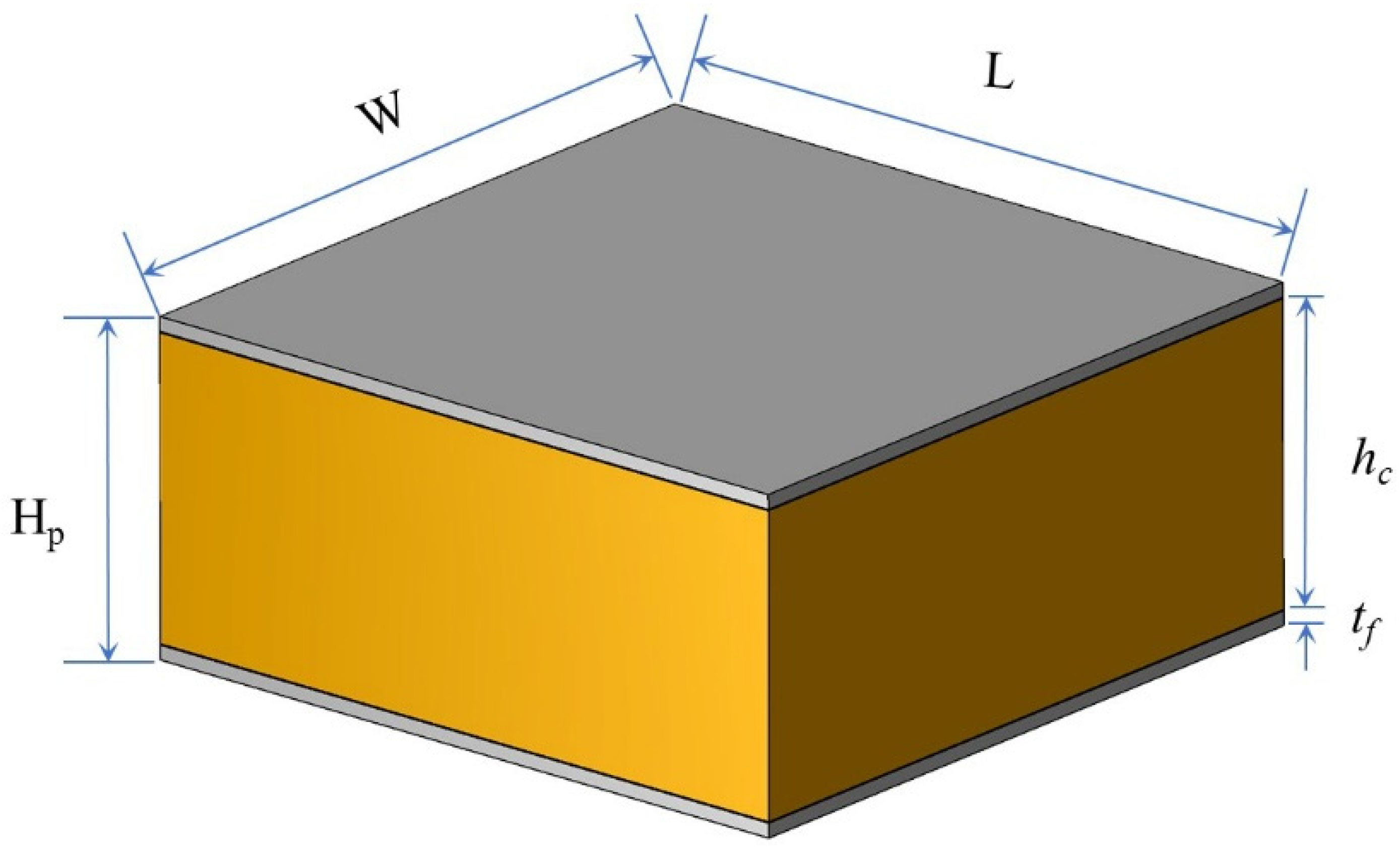
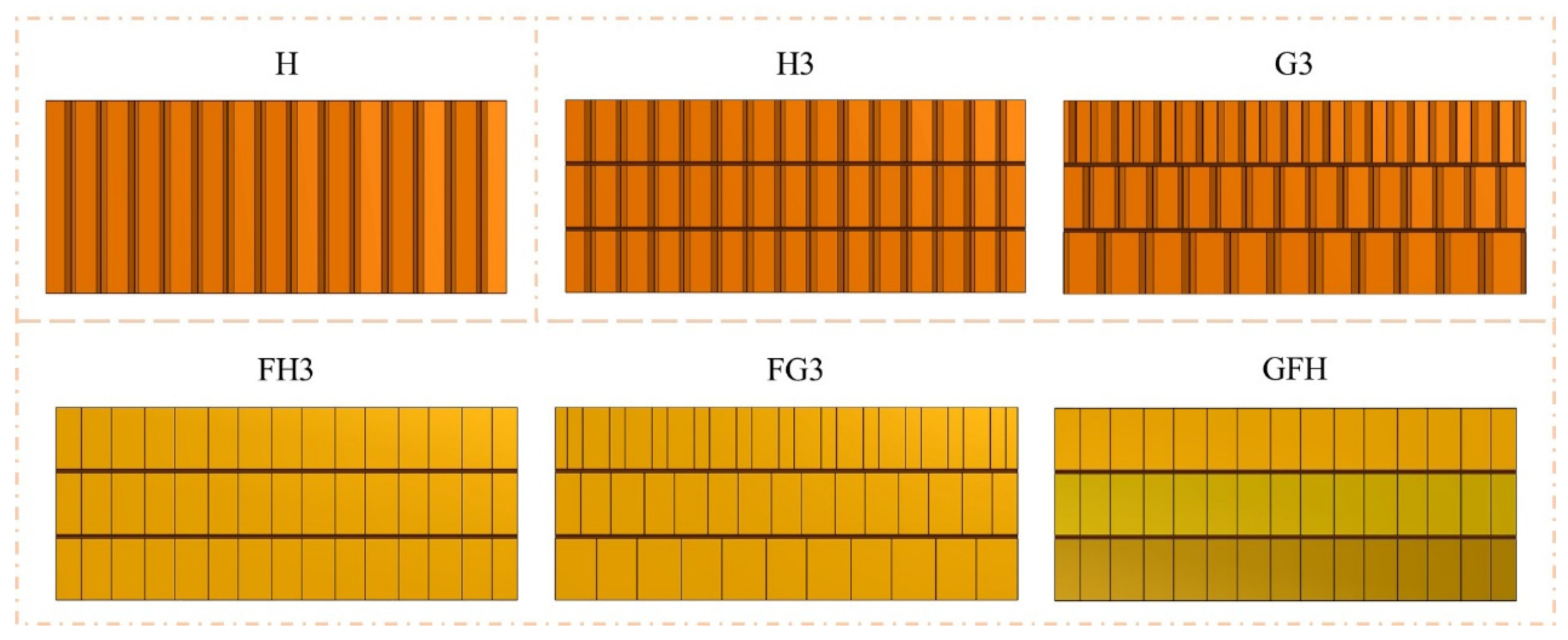

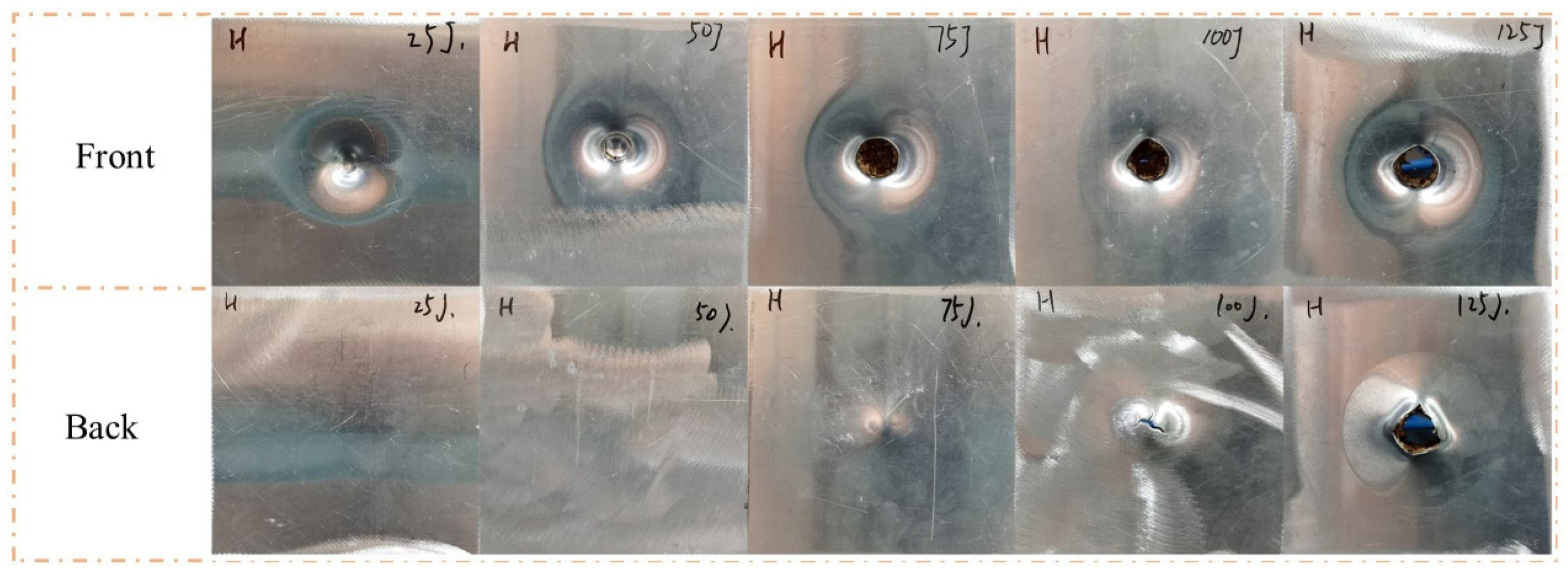




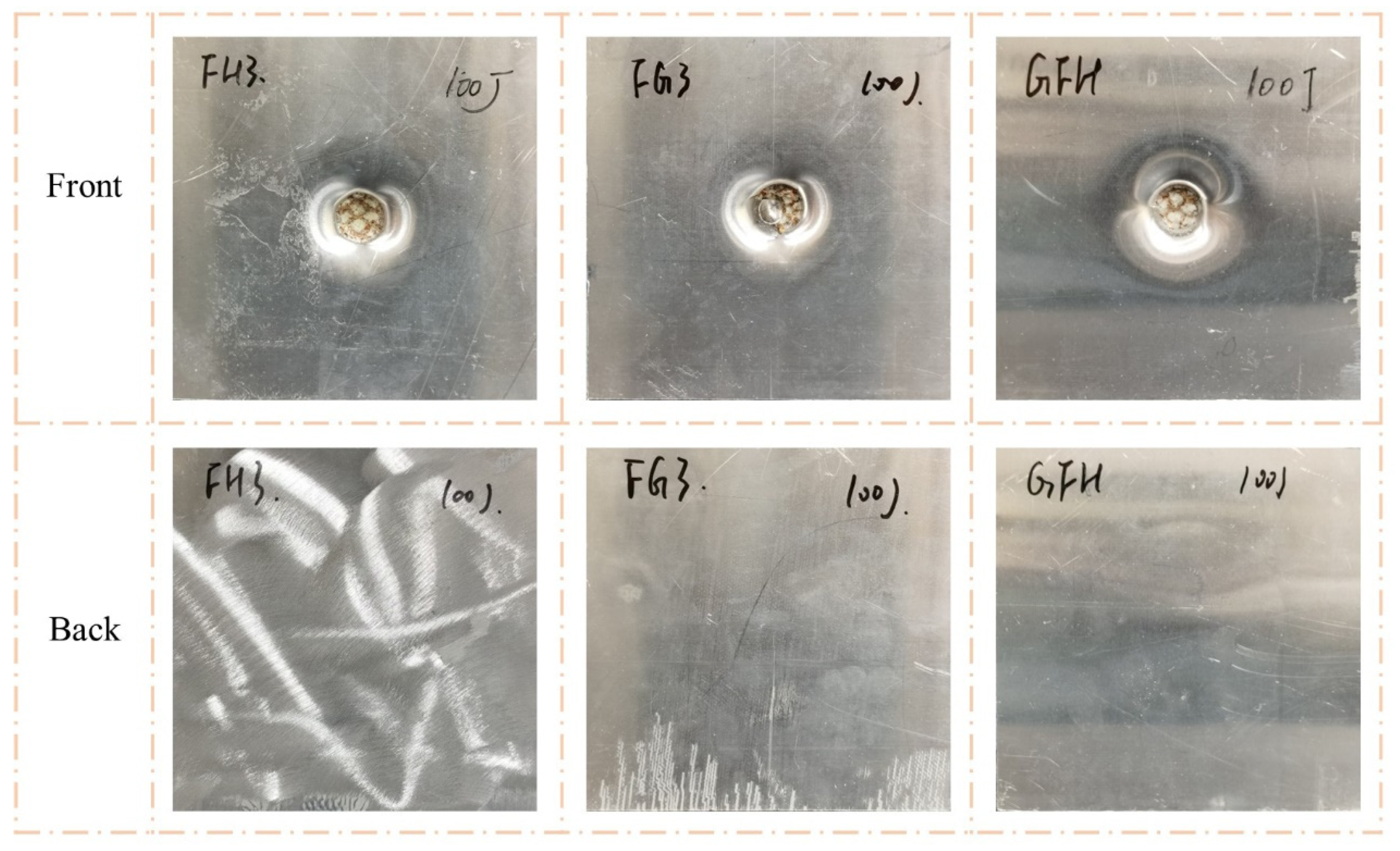

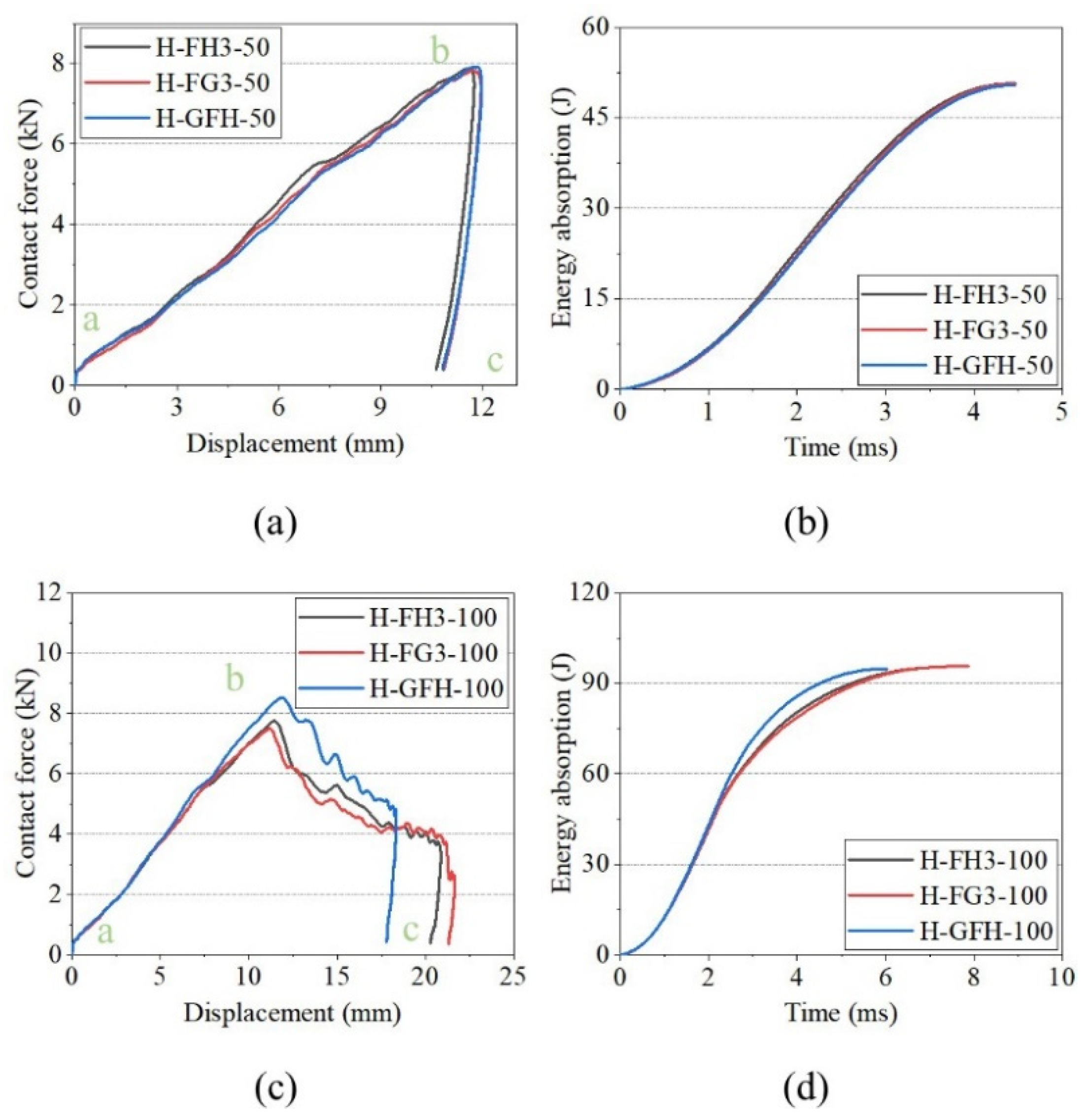
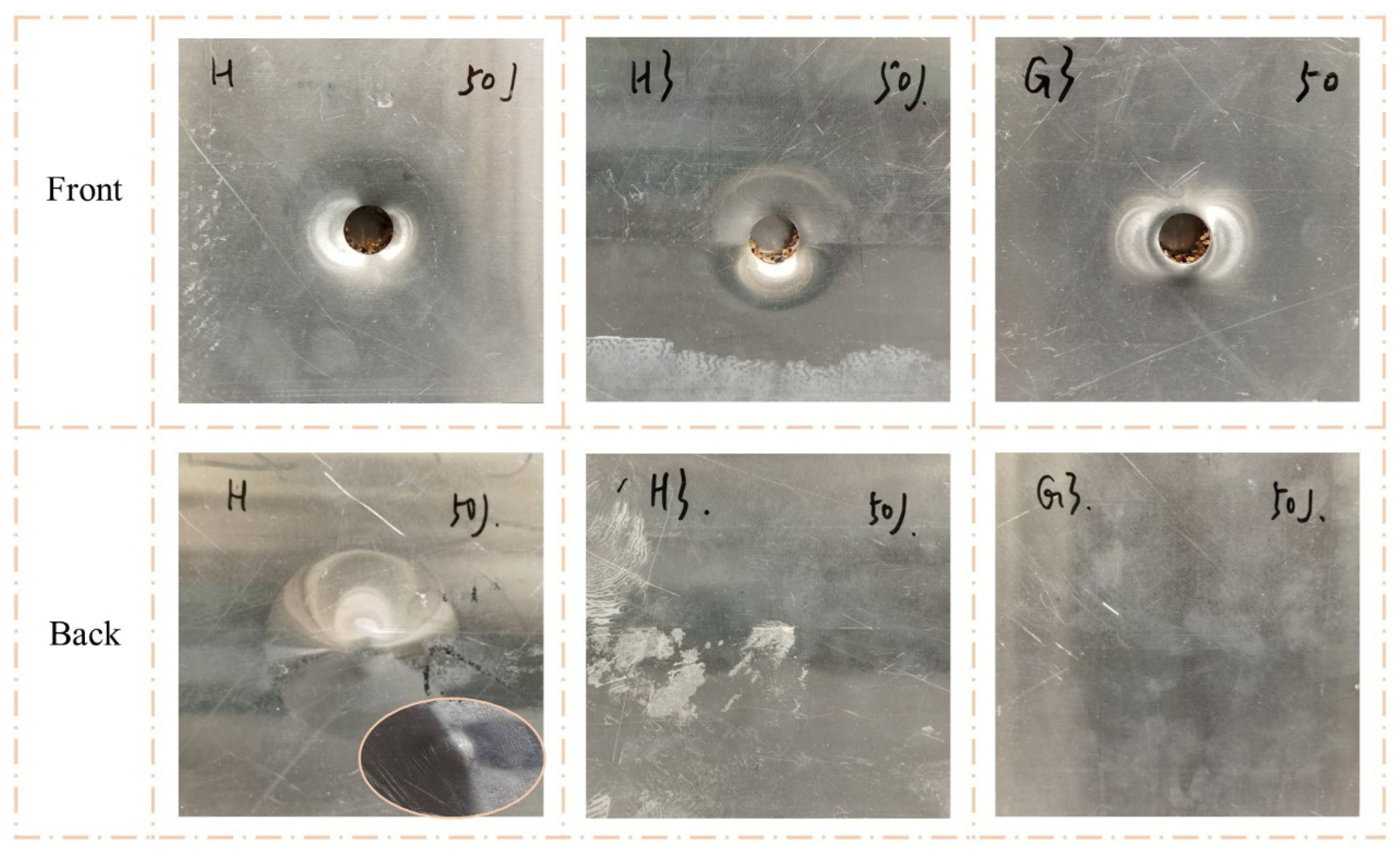
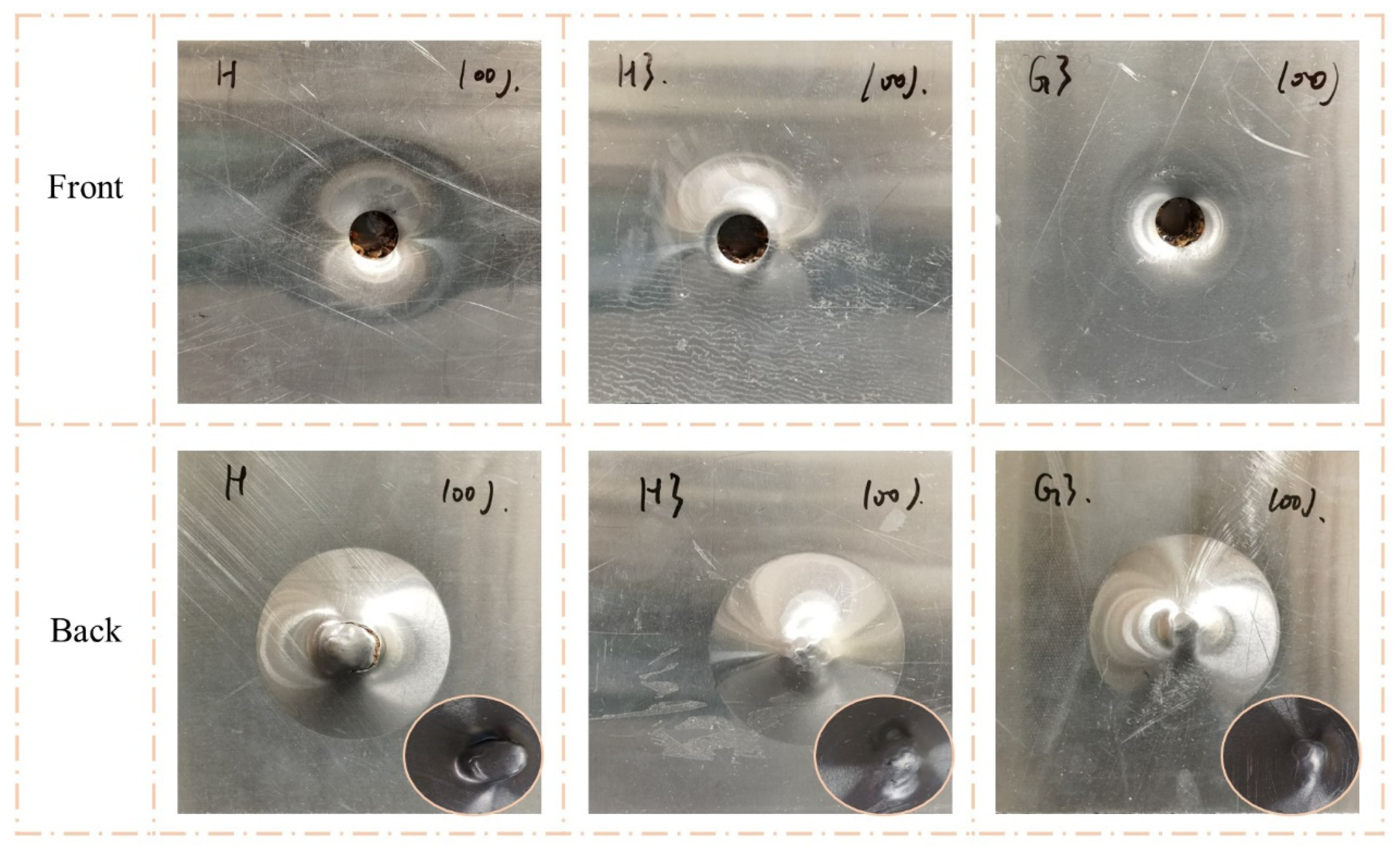




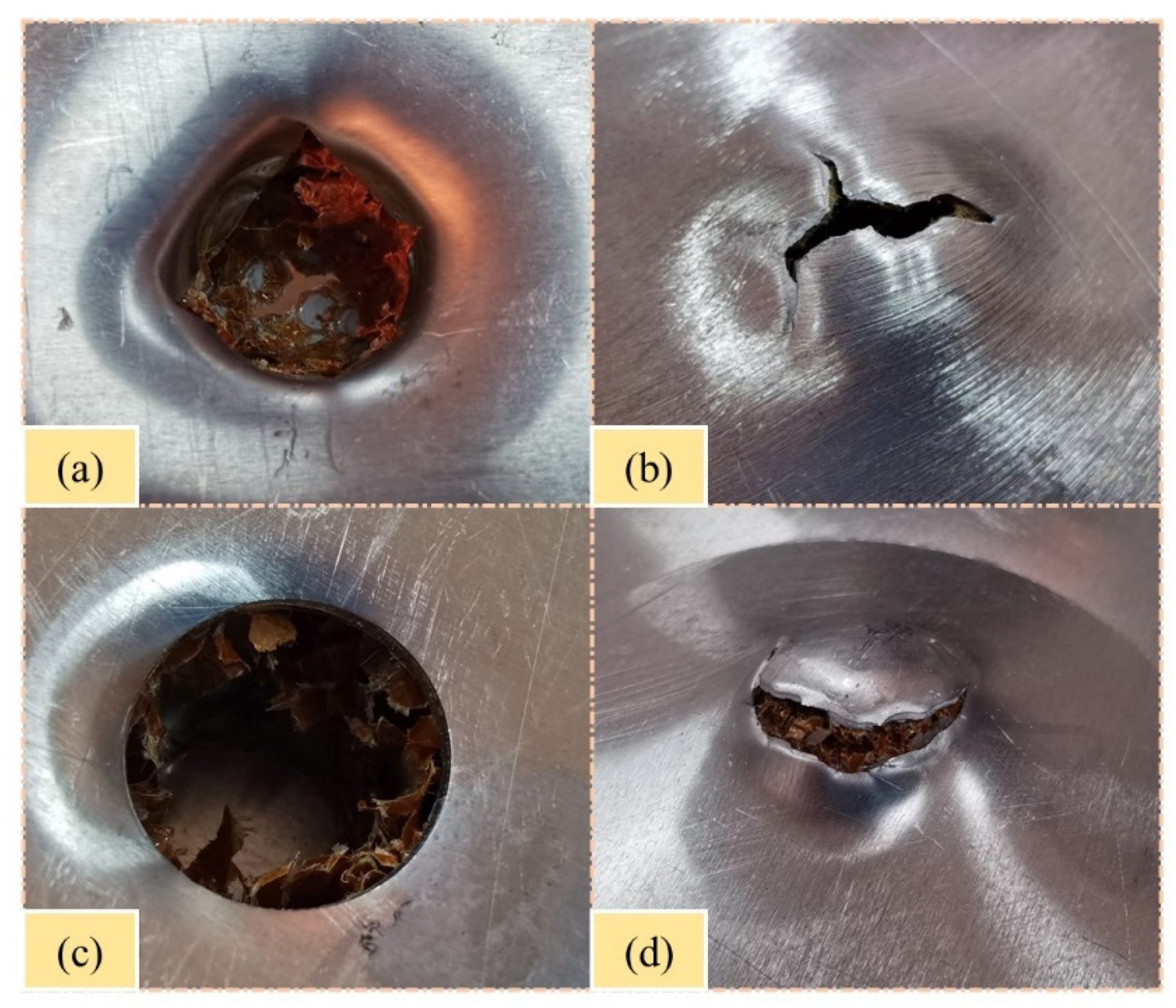
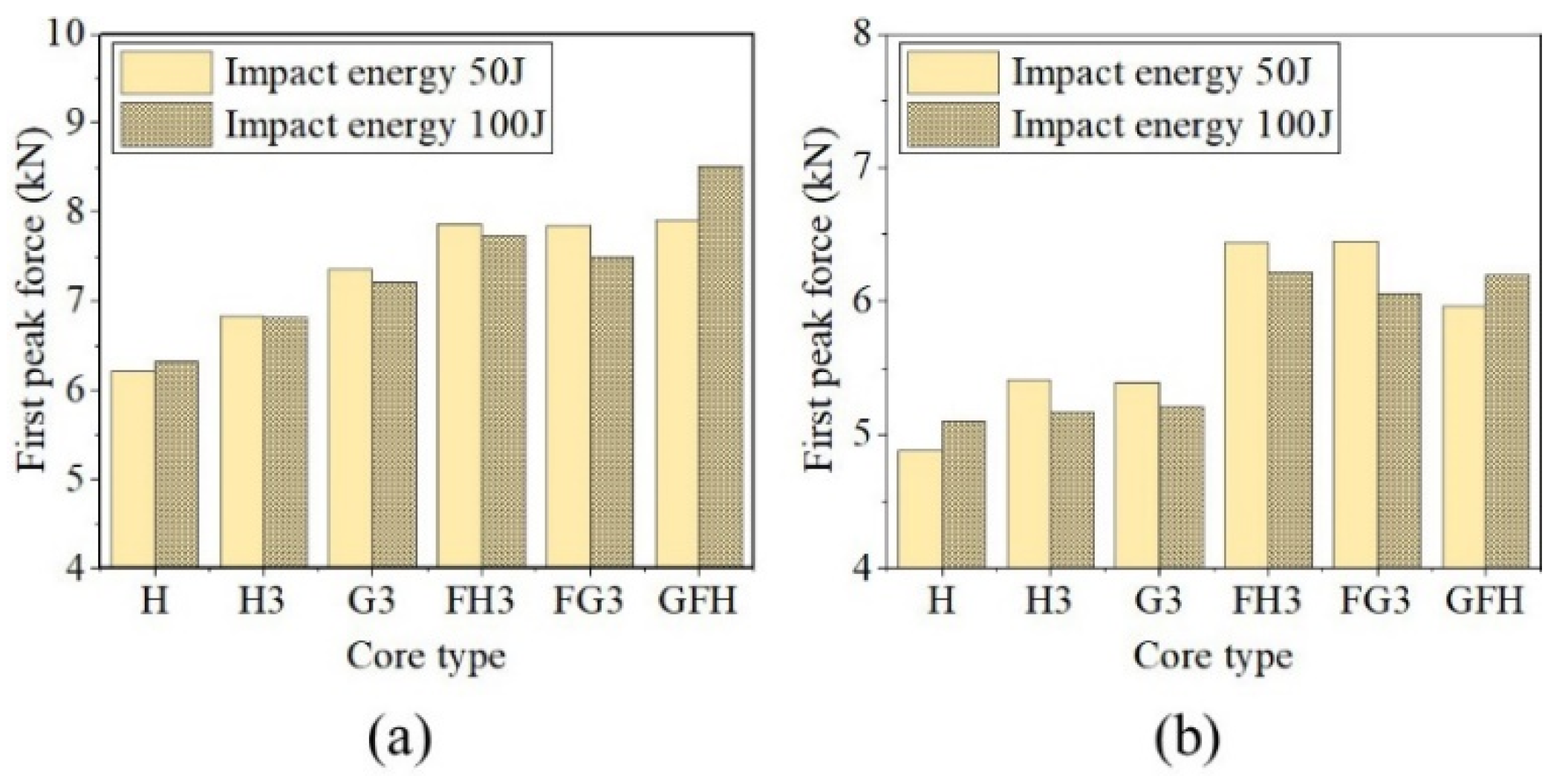
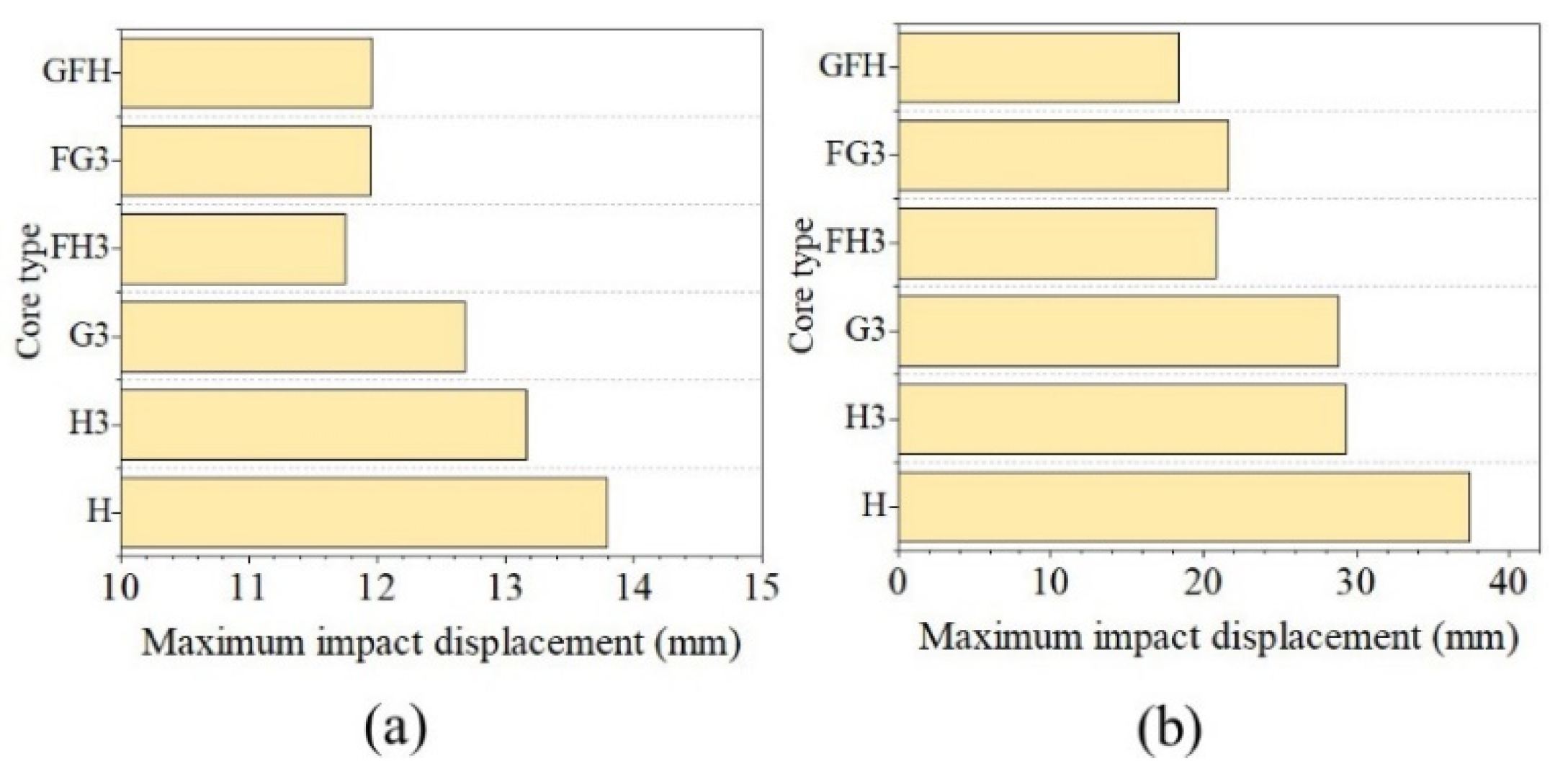
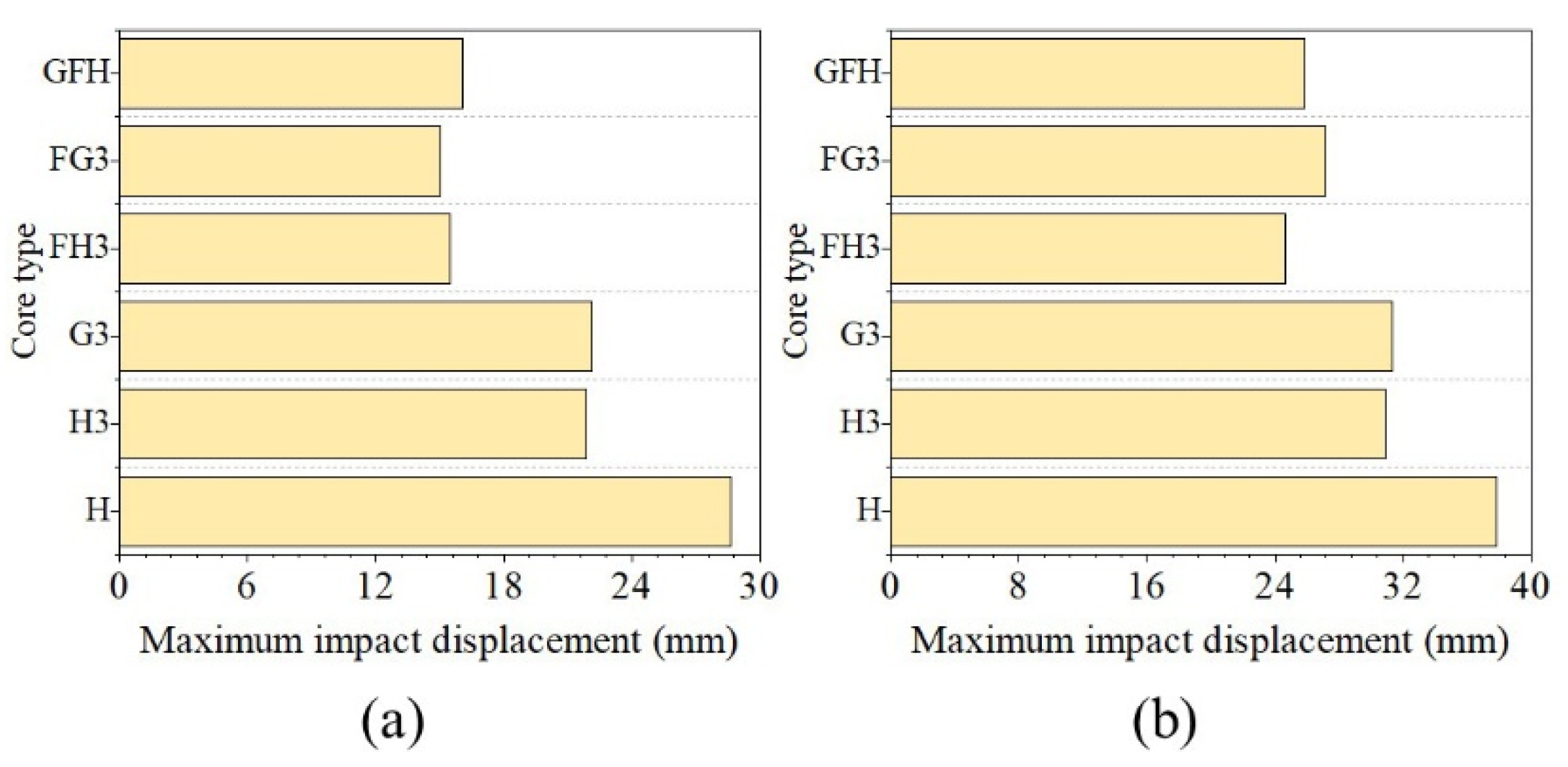
| Honeycomb Type | ρn (kg/m3) | c (mm) | d (mm) | h (mm) | t1 (mm) | t2 (mm) |
|---|---|---|---|---|---|---|
| H367-8 | 48 | 3.67 | 6.36 | 8 | 0.08 | 0.08 |
| H275-8 | 48 | 2.75 | 4.76 | 8 | 0.05 | 0.05 |
| H275-25 | 48 | 2.75 | 4.76 | 25 | 0.05 | 0.05 |
| H183-8 | 48 | 1.83 | 3.17 | 8 | 0.05 | 0.05 |
| L (mm) | W (mm) | Hp (mm) | tf (mm) | hc (mm) |
|---|---|---|---|---|
| 150 | 150 | 27.4 | 1.2 | 25 |
| Structure Type | Structure Name | Honeycomb Type | Foam Density |
|---|---|---|---|
| Single-layer core | H | H275-25 | —— |
| Multiple-layer core | H3 | H275-8 | —— |
| G3 | H183-8 H275-8 H367-8 | —— | |
| Hybrid core | FH3 | H275-8 | 50 kg/m3 |
| FG3 | H183-8 H275-8 H367-8 | 50 kg/m3 | |
| GFH3 | H275-8 | 50 kg/m3 60 kg/m3 80 kg/m3 |
| Core Type | Impact Energy 50 (J) | Impact Energy 100 (J) | ||||||
|---|---|---|---|---|---|---|---|---|
| 1st Peak (N) | Change Value | Disp. (mm) | Change Value | 1st Peak (N) | Change Value | Disp. (mm) | Change Value | |
| H | 6205.30 | 0.00% | 13.79 | 0.00% | 6315.16 | 0.00% | 37.43 | 0.00% |
| H3 | 6830.34 | 10.07% | 13.16 | −4.57% | 6808.24 | 7.81% | 29.34 | −21.61% |
| G3 | 7358.20 | 18.58% | 12.69 | −7.98% | 7204.66 | 14.09% | 28.82 | −23.00% |
| FH3 | 7855.56 | 26.59% | 11.75 | −14.79% | 7741.94 | 22.59% | 20.86 | −44.27% |
| FG3 | 7837.56 | 26.30% | 11.95 | −13.34% | 7490.29 | 18.61% | 21.64 | −42.19% |
| GFH | 7909.55 | 27.46% | 11.96 | −13.27% | 8515.39 | 34.84% | 18.35 | −50.98% |
| Core Type | Impact Energy 50 (J) | Impact Energy 100 (J) | ||||||
|---|---|---|---|---|---|---|---|---|
| 1st Peak (N) | Change Value | Disp. (mm) | Change Value | 1st Peak (N) | Change Value | Disp. (mm) | Change Value | |
| H | 4884.07 | 0.00% | 28.64 | 0.00% | 5105.10 | 0.00% | 37.85 | 0.00% |
| H3 | 5415.19 | 10.88% | 21.9 | −23.53% | 5168.81 | 1.25% | 30.91 | −18.34% |
| G3 | 5385.98 | 10.28% | 22.12 | −22.77% | 5214.20 | 2.14% | 31.34 | −17.20% |
| FH3 | 6437.50 | 31.81% | 15.46 | −46.02% | 6217.54 | 21.79% | 24.63 | −34.93% |
| FG3 | 6445.50 | 31.97% | 15.05 | −47.45% | 6051.75 | 18.54% | 27.13 | −28.32% |
| GFH | 5957.22 | 21.97% | 16.05 | −43.96% | 6188.63 | 21.22% | 25.89 | −31.60% |
Disclaimer/Publisher’s Note: The statements, opinions and data contained in all publications are solely those of the individual author(s) and contributor(s) and not of MDPI and/or the editor(s). MDPI and/or the editor(s) disclaim responsibility for any injury to people or property resulting from any ideas, methods, instructions or products referred to in the content. |
© 2023 by the authors. Licensee MDPI, Basel, Switzerland. This article is an open access article distributed under the terms and conditions of the Creative Commons Attribution (CC BY) license (https://creativecommons.org/licenses/by/4.0/).
Share and Cite
Fan, J.; Li, P.; Guo, W.; Zhao, X.; Su, C.; Xu, X. Experimental Investigation on the Low-Velocity Impact Response of Tandem Nomex Honeycomb Sandwich Panels. Polymers 2023, 15, 456. https://doi.org/10.3390/polym15020456
Fan J, Li P, Guo W, Zhao X, Su C, Xu X. Experimental Investigation on the Low-Velocity Impact Response of Tandem Nomex Honeycomb Sandwich Panels. Polymers. 2023; 15(2):456. https://doi.org/10.3390/polym15020456
Chicago/Turabian StyleFan, Jinbo, Penghui Li, Weiqi Guo, Xiuguo Zhao, Chen Su, and Xinxi Xu. 2023. "Experimental Investigation on the Low-Velocity Impact Response of Tandem Nomex Honeycomb Sandwich Panels" Polymers 15, no. 2: 456. https://doi.org/10.3390/polym15020456
APA StyleFan, J., Li, P., Guo, W., Zhao, X., Su, C., & Xu, X. (2023). Experimental Investigation on the Low-Velocity Impact Response of Tandem Nomex Honeycomb Sandwich Panels. Polymers, 15(2), 456. https://doi.org/10.3390/polym15020456






